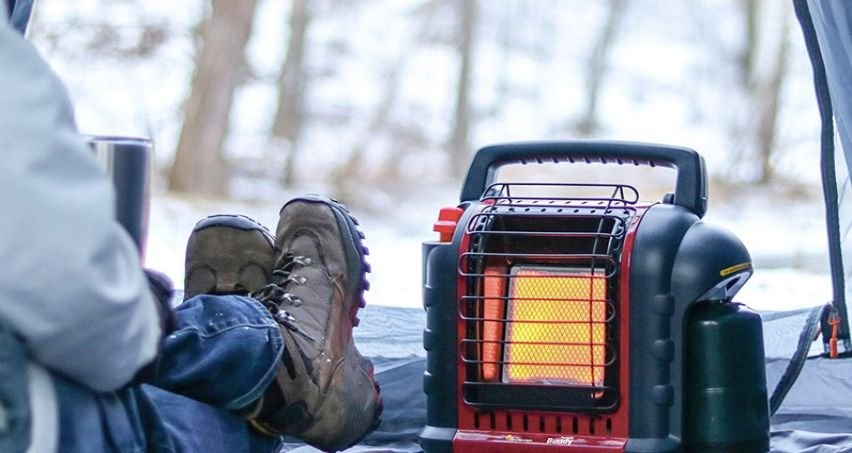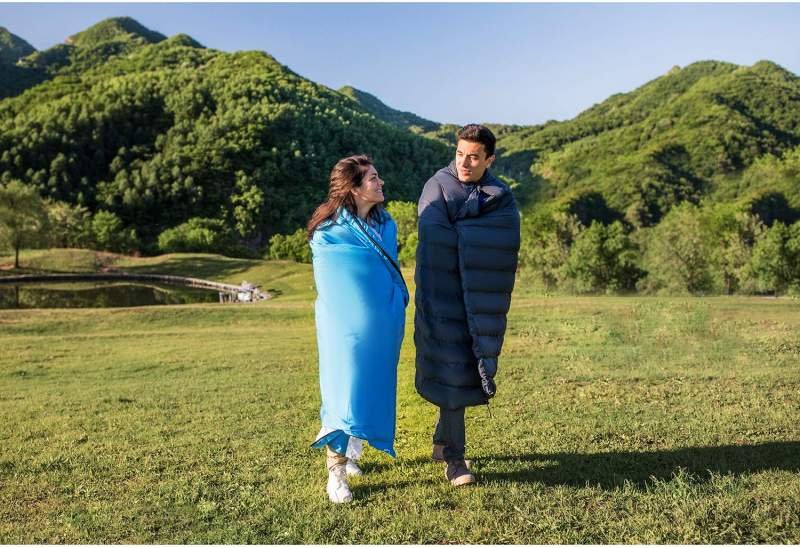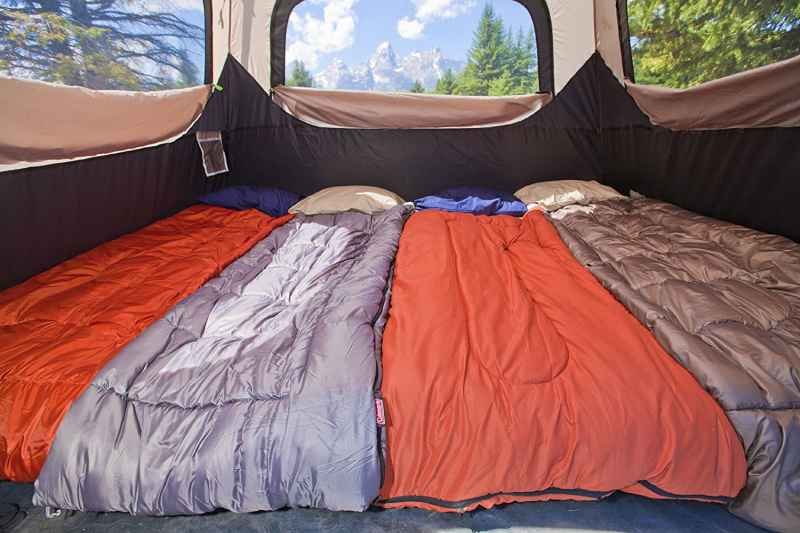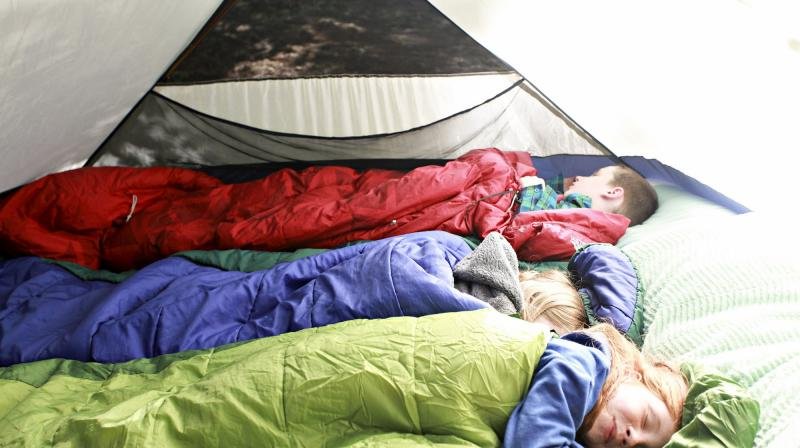Understanding how to keep warm in a tent is crucial for winter and cool weather camping trips. Even in warm conditions during the day, some locations can experience severe drops in temperature, leading to an unbearably chilly night. In order to get the best nights sleep, and avoid serious situations like frostbite, you need to learn how to keep warm during winter camping.
I’m sure we’ve all been there at some point in our lives – a cold, wet tent that feels impossible to warm up. You can’t feel your toes, your fingers are numb, and it feels like it’s below freezing (and it sure as heck might be, too). There are certain precautions one must take to avoid these kinds of situations, and it’s doesn’t end at just making sure your tent doesn’t leak when it rains.
Keeping warm in a tent encompasses many different aspects, from choosing the right gear, to knowing what to do before going to bed. Get rid of dreadful shivering nights for good with our guide to staying warm and cozy inside a tent.
Page Contents:
5 Top Tips to Keep a Tent Warm
1. Camping Tent Heaters
Ok, so this is certainly the most obvious choice. Heaters for tents will heat things up quickly because they sit inside and can be directed toward a particular area, like your bed.
While there aren’t any rules stating you can’t use one of these in a small 1, 2, or 3-person capacity tent, we think they’re best used in larger sizes. This is due to the larger surface area that needs heat coverage, and a heater or portable radiator can achieve this. We also think it should be used in addition to other measures, like your sleeping gear and tent construction.
Things to remember:
- VENTILATE! We can’t stress enough how important it is to make sure that your space is well ventilated when using a heater inside a tent. This is because a stuffy tent can lead to a build up in humidity, which is basically condensation. This means dampness, which is a huge cause of feeling cold. While it might seem a little odd to think you should open your vents and some windows throughout the night, it’s essential for reducing the level of condensation and keeping you dry and snug. Plus, when air is circulating, you won’t sweat as much which helps to keep you dry and comfortable.
- Don’t leave it on all night. Yes, I know, it’s tempting to keep it on all throughout the night. But it can be dangerous, as tent heaters should always be supervised. What you should do is leave it running until just before nodding off to sleep, where you can turn it off and rest assured nothing bad will happen throughout the night.
There are several pros and cons between using either an electric or gas heater.
Electric Pros: You don’t need fuel tanks, it consumes barely any oxygen, most are highly portable, and it doesn’t generate carbon monoxide.
Electric Cons: An outlet is required, you need a tent with an electric port opening, it uses quite a bit of power, there is a risk of fire.
Gas Pros: No need for an electrical outlet, can produce a lot of heat, warms things up fast.
Gas Cons: There is a slight risk of carbon monoxide and oxygen reduction, there is a risk of fire.
To choose a heater out of the best on the market, don’t miss our tent heater reviews that cover some of the best you can find for sale today.
2. Why a Camping Blanket can be a Godsend
Unlike regular blankets, camping blankets or quilts are specially designed for – you guessed it – camping. They are much thicker, more durable and protective than any blanket you’d have lying around at home.
Plus, most of them can be folded down for compact storage in your gear, are machine washable without ruining the materials, and give you increased control over thermal levels.
These are typically used on top of sleeping bags when temps outside are below freezing, or you could use them in place of a sleeping bag when you’re resting on a camping pad and want more control over your body temperature. Insulation options include synthetic down and duck down.
Something else that’s great about these blankets is that they can prevent sweating, which can be caused by sleeping bags if you don’t have the proper ventilation in your tent. Since you’re not tucked up in a tight bag, you can stretch out your legs and arms, wrap it around yourself when you’re cold, or stick a leg out to cool down if you’re too hot.
Mylar or thermal blankets are another option for keeping your tent warm. Use them in multiple different ways to increase the temperature – wrap it around your sleeping bag, put it between your body and sleeping bag or mattress, or drape it over your tent during the day and let the sun do all the work.
If you’re struggling with narrowing down a choice, check out our comprehensive review of the best camping quilts out there.
3. The Importance of a Proper Camping Sleeping Bag
If you’re looking to buy a sleeping bag or ready for a new one, don’t get tempted by cheap prices or deals without properly investigating the materials and insulation capability.
Something we should mention is the use of air mattresses in combination with a sleeping bag. While they’re definitely a comfy spot to sleep, making you feel like you’re at home, sometimes they’re not the best choice for helping you stay warm. This is because they aren’t amazing insulators.
They can trap your body in a constant wave of cool air because it’s being sucked in from the top and bottom. If you’re going to go for a mattress, look for one that has insulation properties, like a heat regulation foam.
A true high-quality sleeping bag for camping is going to do wonders for raising your body heat at night. Sometimes, you might find yourself removing layers of clothing because it’s so incredibly warm. These also generally come with either synthetic or down insulation like the blankets, and both have their positives and negatives.
Synthetic Benefits:
- Reduces allergies with hypoallergenic properties
- Tend to be less pricey
- Generates heat, even it gets wet
- Dries fast to prevent your body from getting cold
Duck Down Benefits:
- Long-lasting for almost a lifetime of use
- Lightweight which means less weight in your bag
- Compresses easily
- Extremely high performing in cold weather
Proper sleeping bags usually also have something called draft tubes (also called zipper baffles) which are found on the edges. They prevent cold air from creeping its way inside, when compared to exposed zippers that have tiny openings and let a draft through.
A hood on the bag is something else to look out for. Some models let you take the hood off, while others have it there permanently. It acts like a beanie or soft helmet that doesn’t allow your head to lose any heat. You can also find some designs with drawstrings to close yourself up in a cocoon.
All of these elements will help you maintain body heat, thus increasing your warmth inside the tent. To find the best design for you, take a look at camping sleeping bag reviews where we chose the best ones on the market.
4. Food & Water
These factors might get overlooked, since you might not immediately expect your nutrition and hydration choices to affect your warmth.
The fact is that your metabolism can have a lot to do with regulating your body temperature. If you haven’t eaten, or ate a small meal, you body can struggle to heat itself because it won’t be going through the process of digestion.
That’s why it’s recommended to eat a good, high-fat/high-protein meal or snack before you head off to bed.
Now let’s talk about hydration.
You may not detect that you’re thirsty when it’s cold as much as when it’s hot, so drink up. While you definitely need to keep the water flowing, it’s important to note that too much water can cause you to go to the bathroom all throughout the night. To avoid getting out of the warm embrace of your sleeping bag or blanket, drink less water before bed and go to the toilet before lying down.
5. Bedtime Tips
So, you’re all set with the right gear. Everything is laid out nicely, ready to keep you snug throughout the night and send you off in a deep sleep.
But before you hit the hay, there are some steps you should take in order to keep the warmth going:
- Jump up and down. Yep, you read that right, jump up and down, do some push ups, burpees, and sit ups before snuggling under the covers. Exercising beforehand will help to get your blood pumping, thus making your body feel much warmer. Don’t make it too intense because you’ll start to sweat, and also change into your PJ’s once you’re inside your sleeping bag or under your quilt. Plus, if you exercise a little, it stops you from going to bed when you’re cold. If that happens, then it can be difficult to warm back up again.
- Use a hot water bottle as your cuddle buddy. A BPA-free one is the way to go, and all you need to do is pour some almost boiling water in it just before calling it a day.
- Dry out your sleeping bag. During the day, make it a routine to roll out the bag and let it air out. This helps to dry any moisture that may have formed from your body heat, thus reducing the risk of making you chillier during the night.
- Wear comfy PJ’s. Let’s be real here, it’s not a fashion show! You don’t need to wear your cutest or most stylish PJ’s to bed. Your best bet is some fleece ones, as they’re keep you extra cosy.
- Be kind to your extremities. Your extremities are your fingers, toes, and your head. These areas lose heat the fastest, so you need to keep them as warm as possible. This means wearing a beanie (or using a sleeping bag hood as you saw before), possibly wearing gloves, and definitely wearing woolly socks.
Conclusion on Keeping Warm in a Tent
You never know how cold it can truly get in the outdoors, which is why it’s so essential to know what you’re doing and know how to keep warm in a tent. It’s important to stay prepared, and as you’ve seen in our guide, there are ultimately just a few steps you need to take that will become second nature to you overtime.

![How To Keep Warm in a Tent All Winter [Proven Tips]](https://thetenthub.com/wp-content/uploads/2020/10/How-To-Keep-Warm-in-a-Tent-All-Winter-Proven-Tips-930x563.jpg)





